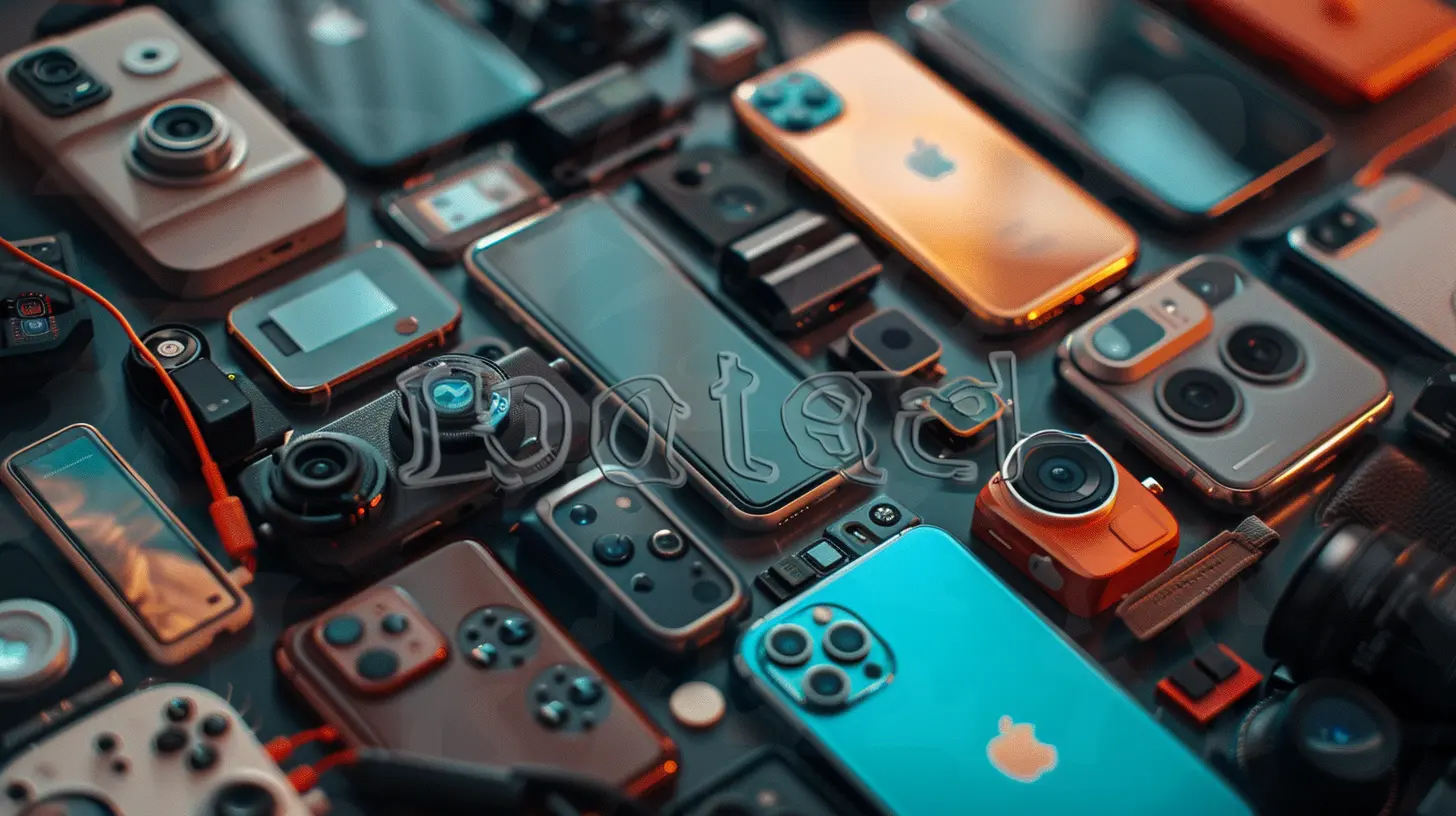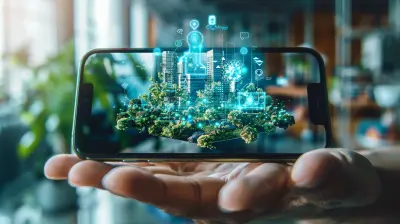How Smartphone Design Has Evolved Over the Decades
22 November 2024
Smartphones have become an essential part of our lives, haven’t they? Whether you’re texting, scrolling through social media, or binge-watching the latest Netflix series, it's hard to imagine a world without them. But if we take a moment to step back, it’s clear that smartphones have come a long way. From bulky, chunky devices to sleek, almost futuristic gadgets, the transformation has been nothing short of impressive.
In this article, we’re diving into the fascinating evolution of smartphone design over the decades. Buckle up, because we’re about to take a trip down memory lane and explore how smartphones became the design marvels they are today.

The Humble Beginnings: The Birth of Mobile Phones
Let’s rewind to the 1980s — an era of big hair, neon colors, and, of course, the birth of the mobile phone. The early designs weren’t what you’d call “smart,” but they were revolutionary for their time. The Motorola DynaTAC 8000X, released in 1983, was the world’s first commercially available mobile phone. Weighing around 2.5 pounds (yes, pounds!), this chunky brick was far from portable in today's sense of the word. But you know what? It was a game-changer.Why? Because it allowed people to make calls on the go, something that was previously unimaginable. However, beyond the ability to make a call, there wasn’t much else going on. Features like texting, internet browsing, or even a color screen weren’t even on the radar.
The 1990s: Shrinking Sizes and the Birth of the Flip Phone
As we rolled into the 1990s, mobile phones began to slim down — though the term “slim” is relative. Companies like Nokia and Motorola started focusing on making phones more compact and easier to carry. Remember the Motorola StarTAC? Released in 1996, it was one of the first flip phones and weighed just 3.1 ounces. That was a huge leap forward in terms of portability.While the design was still bulky by today’s standards, the compact flip phone was a sign of things to come. These phones were durable (you could literally drop them down a flight of stairs, and they’d survive), and they introduced basic texting features.
By the late 1990s, phones like the Nokia 5110 came onto the scene, and they had interchangeable faceplates. This allowed users to personalize their devices for the first time, adding a splash of personality to what had been a pretty utilitarian gadget.

The 2000s: The Rise of the PDA and Touchscreens
The turn of the millennium brought a huge shift in phone design. As technology advanced, people began to expect more from their mobile devices. Phones weren’t just for talking anymore — they were becoming mini computers.Enter the Personal Digital Assistant (PDA). Devices like the BlackBerry and Palm Pilot allowed users to not only make calls but also send emails, browse the internet, and manage their calendars. These devices had physical keyboards and a more "professional" design, targeting business users who needed to stay connected on the go.
But let’s talk about the real game-changer: the touchscreen. The LG Prada, released in 2006, was the first mobile phone to feature a capacitive touchscreen. While it didn’t gain widespread popularity, it paved the way for what was to come.
2007: The iPhone Revolution
We can’t talk about smartphone design without mentioning the iPhone. When Steve Jobs took the stage in 2007 and introduced Apple’s first iPhone, it was clear that the mobile phone industry would never be the same.The iPhone ditched the physical keyboard in favor of a fully touch-based interface. It featured a sleek, minimalist design with a glass front and an aluminum back — a stark contrast to the clunky, button-filled phones of the past. The iPhone was not just a phone; it was a camera, an iPod, and an internet browser all rolled into one.
What made the iPhone stand out wasn’t just its functionality, but its design ethos. Apple focused on simplicity, elegance, and user experience. The home button was the only physical button on the front, and everything else was controlled through the touchscreen. The iPhone’s design became the blueprint for the modern smartphone.

The 2010s: Bigger Screens, Thinner Bodies, and the Death of Buttons
As we moved into the 2010s, smartphone design continued to evolve at a rapid pace. One of the most noticeable trends? Screens kept getting bigger and bezels kept getting smaller.Take the Samsung Galaxy S series, for example. Launched in 2010, the Galaxy S had a 4-inch screen, but by the time the Galaxy S10 rolled around in 2019, screens had grown to a whopping 6.1 inches. What’s more, the bezels (the borders around the screen) had almost disappeared, giving users more display without increasing the overall size of the phone too much.
Thin Is In
Another trend that dominated the 2010s was the obsession with thinness. Companies like Apple and Samsung continually pushed the boundaries to make their devices as slim and lightweight as possible. The iPhone 6, released in 2014, was just 6.9mm thick, and the trend toward thinner and lighter devices continued throughout the decade.The Death of the Home Button
Remember the home button we mentioned earlier? Well, by the late 2010s, it was on its way out. Apple removed the home button entirely with the release of the iPhone X in 2017, replacing it with Face ID and gesture-based navigation. This allowed for an even larger screen while maintaining a compact form factor.
The 2020s and Beyond: Foldables, Rollables, and Minimalism
Here we are in the 2020s, and smartphone design is still evolving at a breakneck pace. As consumers demand more functionality and innovation, companies have started exploring new form factors that once seemed like science fiction.Foldable Phones: The Future or a Fad?
Foldable phones have made a splash in recent years. Devices like the Samsung Galaxy Z Fold and Motorola Razr (yes, it’s back!) offer users the ability to fold their phones in half, essentially giving them a tablet-sized screen that can fit in their pocket. While foldable phones are still in their early stages, they represent a bold new direction for smartphone design.Rollable Screens: A Glimpse into the Future
Not satisfied with folding screens? How about rollable screens? Companies like LG and Oppo have teased rollable phone designs that allow the screen to expand and contract like a scroll. While these phones haven’t hit the mainstream market yet, they give us a glimpse into the future of smartphone design.Minimalism Reigns Supreme
In contrast to the experimental designs of foldables and rollables, minimalism continues to dominate the mainstream smartphone market. Phones like the iPhone 13 and Google Pixel 6 feature sleek, minimalist designs with clean lines and premium materials. Gone are the days of buttons and bezels — today’s smartphones are all about maximizing screen space and minimizing distractions.The Role of Materials: Glass, Metal, and Beyond
Over the years, smartphone designs have also evolved in terms of the materials used. Early mobile phones were made from plastic, which made them durable but not exactly premium. In contrast, today’s smartphones are crafted from materials like glass and aluminum, giving them a more luxurious feel.In recent years, companies have also started experimenting with more eco-friendly materials. For example, Fairphone has made waves by using recycled materials and ethical sourcing practices in its smartphone designs.
What’s Next for Smartphone Design?
So, where do we go from here? Well, if the past is any indication, the future of smartphone design will likely be full of surprises. As technology advances, we can expect to see even more innovative designs, whether it’s foldables, rollables, or something we haven’t even thought of yet.We may also see the rise of modular smartphones, where users can swap out components like the camera or battery without having to replace the entire device. And with the growing focus on sustainability, future smartphones may be designed with more eco-friendly materials and longer lifespans.
One thing's for sure: the evolution of smartphone design is far from over. And as we continue to demand more from our devices, designers and engineers will keep pushing the boundaries of what’s possible.
Conclusion
From the bulky bricks of the 1980s to the sleek, foldable devices of today, smartphone design has come a long way. Each decade has brought new innovations, transforming the mobile phone from a simple communication tool into an all-in-one device that fits in your pocket. As we look to the future, it’s clear that the journey of smartphone design is far from over — and we can’t wait to see what’s next.all images in this post were generated using AI tools
Category:
SmartphonesAuthor:

Reese McQuillan
Discussion
rate this article
24 comments
Velma Chapman
What a delightful journey through smartphone design! It’s amazing to see how far we’ve come from bulky bricks to sleek, powerful devices that fit in our pockets. Each innovation reflects our ever-changing needs and creativity. Here’s to the future—can’t wait to see what’s next! 🌟📱
February 3, 2025 at 12:34 PM

Reese McQuillan
Thank you! It's exciting to reflect on this evolution and imagine what innovations the future holds. Your enthusiasm is contagious! 🌟📱
Arden McClure
Absolutely loved this article! It's fascinating to see how smartphone design has transformed from clunky bricks to sleek, powerful devices. Each decade brings exciting innovations that enhance our lives. Can't wait to see what the future holds for our beloved tech companions! 🌟📱
January 30, 2025 at 5:37 AM

Reese McQuillan
Thank you! I'm glad you enjoyed the article. The evolution of smartphone design is indeed exciting, and it's fascinating to think about what innovations lie ahead! 🌟📱
Reid Bell
From brick-like beginnings to sleek marvels, smartphone design tells a tale of innovation and desire. What secrets do the next generations hold? Unseen influences may just shape the future in unexpected ways.
January 23, 2025 at 12:02 PM

Reese McQuillan
Thank you for your insightful comment! The evolution of smartphone design indeed reflects a blend of innovation and consumer desire, and it's exciting to ponder the unseen influences that will shape future generations.
Aiden McKinley
Smartphone design has dramatically transformed, blending innovation and user experience seamlessly, shaping the future of mobile technology.
January 19, 2025 at 9:45 PM

Reese McQuillan
Thank you! It's fascinating to see how design innovations have not only enhanced aesthetics but also significantly improved usability, paving the way for the future of mobile technology.
Jax O'Neal
In silver dreams and glassy frames, Smartphones shape our whispered names. From clunky bricks to sleek finesse, Each curve a dance, each touch a caress. A journey wrought in pixels bright, Where form and function blend in light.
January 15, 2025 at 5:30 AM

Reese McQuillan
Thank you for capturing the essence of smartphone evolution so beautifully! Your poetic reflection highlights the remarkable blend of design and technology that defines our connection to these devices.
Emory Wilkins
From bricks to sleek magic mirrors—smartphones have come a long way, haven’t they?
January 12, 2025 at 9:39 PM

Reese McQuillan
Absolutely! It’s fascinating to see how design innovations have transformed functionality and aesthetics in smartphones over the years.
Ariana Thornton
From bricks to sleek slabs! Who knew our phones would go from 'can you hear me?' to 'can you see me?'
January 10, 2025 at 1:41 PM

Reese McQuillan
Absolutely! It’s fascinating to see how functionality has evolved into sleek design, transforming communication into a visual experience.
Thaddeus Baker
Smartphone design has significantly evolved from bulky devices with physical keyboards to sleek, edge-to-edge displays. This transition reflects advancements in technology, user preferences for minimalist aesthetics, and the growing importance of functionality and portability in our digital lives.
January 7, 2025 at 1:26 PM

Reese McQuillan
Thank you for your insightful comment! Indeed, the evolution of smartphone design showcases a remarkable blend of technological innovation and changing user preferences towards sleek, functional devices.
Davina Hill
Smartphone design has significantly transformed from bulky devices to sleek, feature-rich gadgets. Innovations in materials, displays, and user interfaces reflect our growing demand for both functionality and aesthetics. Exciting times ahead!
January 3, 2025 at 9:40 PM

Reese McQuillan
Thank you for your insightful comment! Indeed, the evolution of smartphone design showcases the perfect blend of functionality and aesthetics, shaping an exciting future for technology.
Blake Sheppard
This article offers a fascinating overview of smartphone design evolution, highlighting key milestones from bulky early models to today's sleek, feature-rich devices. It effectively captures how advancements in technology and user preferences have shaped aesthetics and functionality, showcasing the remarkable journey of smartphones as essential tools in our daily lives.
December 31, 2024 at 3:29 AM

Reese McQuillan
Thank you for your insightful comment! I'm glad you found the article engaging and informative about the evolution of smartphone design.
Kassidy Lawrence
The evolution of smartphone design reflects both technological advancements and shifting consumer preferences. From bulky, function-driven models to sleek, minimalist devices, each era prioritizes usability and aesthetics. This transformation highlights the industry's response to user demands for portability, functionality, and visual appeal, shaping modern communication today.
December 26, 2024 at 12:04 PM

Reese McQuillan
Thank you for your insightful comment! Indeed, the evolution of smartphone design beautifully illustrates the balance between technology and user preferences, driving innovation in both functionality and aesthetics.
Eleanor Tucker
From bricks to beauty!
December 22, 2024 at 4:13 AM

Reese McQuillan
Thank you! It's fascinating to see how far smartphone design has come, transforming from basic functionality to sleek elegance.
Juliet Fields
Past whispers secrets; future designs hold mysteries.
December 16, 2024 at 7:32 PM

Reese McQuillan
Thank you! Indeed, the evolution of smartphone design reflects a rich tapestry of past innovations and future possibilities.
Eden King
Fascinating look at smartphone evolution! It’s amazing how far we've come in design!
December 12, 2024 at 8:59 PM

Reese McQuillan
Thank you! It’s incredible to see how innovation has shaped our devices over the years.
Zevin McGill
Fascinating journey from bricks to sleek.
December 10, 2024 at 11:41 AM

Reese McQuillan
Thank you! It's amazing to see how innovation has transformed our devices into sleek, powerful tools.
Devin Estes
Great insights on tech evolution—truly fascinating journey!
December 5, 2024 at 7:30 PM

Reese McQuillan
Thank you! I'm glad you found it fascinating!
Yasmeen Mahoney
Smartphone design evolution reflects technological advancements, user preferences, and changing aesthetics, shaping our digital interaction.
November 28, 2024 at 11:23 AM

Reese McQuillan
Absolutely! Smartphone design has indeed evolved significantly, driven by innovation, user needs, and aesthetic trends, fundamentally transforming how we interact with technology.
Jemima Dorsey
Love seeing how design shapes our connection!
November 27, 2024 at 5:17 AM

Reese McQuillan
Thank you! It’s fascinating to see how design not only reflects but also enhances our connections.
Kaleb McNulty
Smartphones have come a long way from brick-like devices that made calls and played snake. Now they’re sleek, supercomputers that can take selfies and remind us to drink water. When did my pocket get so smart?
November 25, 2024 at 12:48 PM

Reese McQuillan
Absolutely! It's fascinating how far we've come—what used to be simple communication tools have transformed into essential multi-functional devices that shape our daily lives.
Nina McNulty
Impressive evolution! Each design reflects changing technology and needs.
November 24, 2024 at 5:33 AM

Reese McQuillan
Thank you! I appreciate your insights on how design adapts to reflect technology and user needs.
Oriel Warren
What a fascinating journey through smartphone design! It's incredible to see how far technology has come, shaping our daily lives. This article beautifully captures the evolution of form and function. Excited to see what the future holds for our beloved devices!
November 23, 2024 at 11:48 AM

Reese McQuillan
Thank you! I'm glad you enjoyed the journey through smartphone design. The evolution is truly remarkable, and the future holds even more exciting possibilities!
Phoenix Valentine
Great insights on smartphone design evolution! It's fascinating to see how user needs and technology shape our daily devices.
November 23, 2024 at 4:33 AM

Reese McQuillan
Thank you! I'm glad you found the insights enlightening. It's amazing to witness how user needs and technological advancements continue to drive smartphone innovation.
Journey McClary
Smartphone design has undergone significant transformation since the early models, driven by advancements in technology and changing consumer preferences. Innovations in materials, form factors, and user interfaces have shaped devices for better functionality and aesthetics, reflecting a continuous pursuit of improved user experience and portability.
November 22, 2024 at 9:05 PM

Reese McQuillan
Thank you for your insight! Indeed, the evolution of smartphone design is a fascinating journey of technological advancements and shifting consumer needs.
Oriel Lambert
Great insights on design evolution!
November 22, 2024 at 5:43 AM

Reese McQuillan
Thank you! I'm glad you found it insightful!
MORE POSTS

How Blockchain is Revolutionizing Gadget Supply Chains

The Role of 5G in Enhancing Public Safety

How to Choose Video Editing Software Based on Your Needs

Augmented Reality on Smartphones: What’s Possible Today?

The Role of Big Data in the Future of Wearable Tech

The Promise of Solid-State Batteries in Next-Gen Gadgets

How to Safely Dispose of Old Computer Hardware

Data Center as a Service (DCaaS): The Future of IT Outsourcing

Choosing the Right Smart Display for Your Kitchen: A Guide

G and Its Role in Revolutionizing the Travel Industry

The Benefits of High-Refresh-Rate Monitors for Professional Work

Tackling Climate Change with Quantum Computing: Is It Possible?

Laptops with the Best Built-In Privacy Features: Staying Secure on the Go

Quantum Computing and the Future of Artificial Life Simulation